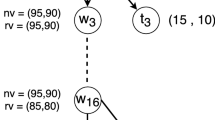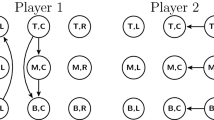Abstract
We introduce the concept of minimal strong curb sets which is a set-theoretic coarsening of the notion of strong Nash equilibrium. Strong curb sets are product sets of pure strategies such that each player’s set of recommended strategies contains all actions she may rationally select in every coalition she might belong to, for any belief each coalition member may have that is consistent with the recommendations to the other players. Minimal strong curb sets are shown to exist and are compared with other well-known solution concepts. We provide a dynamic learning process leading the players to play strategies from a minimal strong curb set only.
Similar content being viewed by others
Notes
Many games of interest lack strong Nash equilibria Aumann (1959).
Players choose pure strategies and hold mixed beliefs. The notion of strong curb set can be easily extended to mixed strategies simply by accommodating the definition of \(\mathrm{CBR}\).
The product set of actions chosen in every strict strong Nash equilibrium is a minimal strong curb set. Conversely, for every minimal strong curb set composed of one action per player, the strategy profile in which each player selects this action is a strict strong Nash equilibrium.
In the appendix we show that the existence result holds for every game \(G\in \mathcal {G}\), where \(\mathcal {G}\) is the class of normal-form games \( G=\left\langle N,\left\{ A_{i}\right\} _{i\in N},\left\{ u_{i}\right\} _{i\in N}\right\rangle \) such that for each player \(i\in N=\left\{ 1,2,\ldots ,n\right\} \), \(A_{i}\) is a compact subset of a metric space and \( u_{i}:\) \(A\rightarrow \mathbb {R} \) is a continuous von Neumann–Morgenstern utility function.
Prep sets (Voorneveld 2004) are product sets of pure strategies such that each player’s set of recommended strategies must contain at least one best-response to whatever belief she may have that is consistent with the recommendations to the other players. Voorneveld (2005) has shown that, in generic games, persistent retracts (Kalai and Samet 1984), minimal prep sets and minimal curb sets coincide. See also Kets and Voorneveld (2008).
References
Ambrus, A.: Coalitional rationalizability. Q. J. Econ. 121, 903–929 (2006)
Ambrus, A.: Theories of coalitional rationality. J. Econ. Theory 144, 676–695 (2009)
Aumann, R.J.: Acceptable points in general cooperative n-person games. In: Tucker, A.W., Luce, R.D. (eds.) Contributions to the Theory of Games IV, pp. 287–324. Princeton University Press, Princeton (1959)
Basu, K., Weibull, J.W.: Strategy subsets closed under rational behavior. Econ. Lett. 36, 141–146 (1991)
Bernheim, B.D., Peleg, B., Whinston, M.D.: Coalition-proof Nash equilibria: I. concepts. J. Econ. Theory 42, 1–12 (1987)
Herings, P.J.J., Mauleon, A., Vannetelbosch, V.: Rationalizability for social environments. Games Econ. Behav. 49, 135–156 (2004)
Hurkens, S.: Learning by forgetful players. Games Econ. Behav. 11, 304–329 (1995)
Kalai, E., Samet, D.: Persistent equilibria in strategic games. Int. J. Game Theory 14, 41–50 (1984)
Kets, W., Voorneveld, M.: Learning to be prepared. Int. J. Game Theory 37, 333–352 (2008)
Luo, X., Yang, C.: Bayesian coalitional rationlizability. J. Econ. Theory 144, 248–263 (2009)
Voorneveld, M.: Preparation. Games Econ. Behav. 48, 403–414 (2004)
Voorneveld, M.: Persistent retracts and preparation. Games Econ. Behav. 51, 228–232 (2005)
Acknowledgments
We thank the editor, an anonymous referee, Jean-François Mertens, Olivier Tercieux and Jorgen Weibull for useful comments and suggestions. Ana Mauleon and Vincent Vannetelbosch are Senior Research Associates of the National Fund for Scientific Research (FNRS), Belgium. Financial support from the Spanish Ministry of Economy and Competition under the project ECO2012-35820 and from the Fonds de la Recherche Scientifique - FNRS research grant J.007315 are gratefully acknowledged.
Author information
Authors and Affiliations
Corresponding author
Appendix
Appendix
We now show that the existence of minimal strong curb sets holds in general. Let \(\mathcal {G}\) be the class of normal-form games \(G=\left\langle N,\left\{ A_{i}\right\} _{i\in N},\left\{ u_{i}\right\} _{i\in N}\right\rangle \) where for each player \(i\in N=\left\{ 1,2,\ldots ,n\right\} \), \(A_{i}\) is a compact subset of a metric space and \(u_{i}:\) \( A\rightarrow \mathbb {R} \) is a continuous von Neumann–Morgenstern utility function. Payoffs are extended to mixed strategies in the usual way. Let \(\Delta (A_{i})\) be the set of Borel probability measures over \(A_{i}\). If \(B_{i}\subseteq A_{i}\) is a Borel set, then \(\Delta (B_{i})\) denotes the set of Borel probability measures with support in \(B_{i}\): \(\Delta (B_{i})=\{\alpha _{i}\in \Delta (A_{i})\mid \alpha _{i}(B_{i})=1\}\). If \(G\in \mathcal {G}\), that is, payoff functions are continuous and strategy sets compact, then each set \(\mathrm{BR} ^{i}(\alpha _{-i})\subseteq A_{i}\) is nonempty and compact. A strong curb set is a product set \(X=\times _{i\in N}X_{i}\) where (a) for each \(i\in N\), \(X_{i}\subseteq A_{i}\) is a nonempty, compact set of pure strategies; (b) \( \forall J\subseteq N,\forall \mathbf {\alpha }=(\alpha _{-1},\ldots ,\alpha _{-n}) \) with \(\alpha _{-i}\in \times _{l\in N{\setminus } \{i\}}\Delta (X_{l}) \), \(i\in N\), \(\mathrm{CBR}^{J}(\mathbf {\alpha })\subseteq \times _{j\in J}X_{j} \).
Theorem 1
Every game \(G\in \mathcal {G}\) has a minimal strong curb set.
Proof
Let Q be the collection of all strong curb sets of G. A is a strong curb set of G since for every \(J\subseteq N\) and \( \mathbf {\alpha }=(\alpha _{-1},\ldots ,\alpha _{-N})\) with \(\alpha _{-i}\in \times _{l\in N{\setminus } \{i\}}\Delta (A_{l})\), \(i\in N\), we have \(\mathrm{CBR} ^{J}(\mathbf {\alpha })\subseteq \times _{j\in J}A_{j}\). So Q is nonempty and partially ordered via set inclusion. According to the Hausdorff Maximality Principle, Q contains a maximal nested subset R. For each \( i\in N\), let \(X_{i}=\cap _{Y\in R}Y_{i}\) be the intersection of player i’s strategies in the nested set R. The set \(X_{i}\) is nonempty since the conditions of the Cantor intersection principle are satisfied, i.e., (i) the collection \(\{Y_{i}\mid Y\in R\}\) is nested and thus satisfies the finite intersection property and (ii) each \(Y_{i}\) is nonempty and compact. It remains to prove that \(X=\times _{i\in N}X_{i}\) is a minimal strong curb set. Take \(\mathbf {\alpha }=(\alpha _{-1},\ldots ,\alpha _{-N})\) with \(\alpha _{-i}\in \times _{l\in N{\setminus } \{i\}}\Delta (X_{l})\), \(i\in N\). We have that \(\mathrm{CBR}^{J}(\mathbf {\alpha })\cap \times _{j\in J}(A_{j}\backslash X_{j})=\emptyset \) for \(J\subseteq N\) since \(\mathrm{CBR}^{J}(\mathbf {\alpha } )\cap \times _{j\in J}(A_{j}\backslash X_{j})=\mathrm{CBR}^{J}(\mathbf {\alpha } )\cap (\times _{j\in J}\cup _{Y\in R}(A_{j}\backslash Y_{j}))\subseteq \mathrm{ CBR}^{J}(\mathbf {\alpha })\cap (\cup _{Y\in R}\times _{j\in J}(A_{j}\backslash Y_{j}))=\cup _{Y\in R}(\mathrm{CBR}^{J}(\mathbf {\alpha } )\cap \times _{j\in J}(A_{j}\backslash Y_{j}))\) and \(\mathrm{CBR}^{J}(\mathbf { \alpha })\cap \times _{j\in J}(A_{j}\backslash Y_{j})=\emptyset \) for all \( Y\in R\) (Y is a strong curb set). This establishes that X is a strong curb set. The fact that it is minimal follows directly from the fact that R is a maximal nested subset of Q. \(\square \)
Rights and permissions
About this article
Cite this article
Grandjean, G., Mauleon, A. & Vannetelbosch, V. Strongly rational sets for normal-form games. Econ Theory Bull 5, 35–46 (2017). https://doi.org/10.1007/s40505-016-0095-y
Received:
Accepted:
Published:
Issue Date:
DOI: https://doi.org/10.1007/s40505-016-0095-y




